
Coil slitting: all you need to know
Coil slitting is the process of cutting wide metal coils into narrower coils.
The slit pieces are cut at a smaller width whilst retaining the same length. Prior to being slit, the original coils are placed on an uncoiler drum for uncoiling, before being flattened on a leveller ready for slitting.
What determines the blade configuration during the slitting?
Coil slitting can be applied on both coil and sheet rolls. The blades on the slitter must be adjusted based on the tolerance that needs to be maintained throughout the slitting, and the type and thickness of the material being slit.
To achieve uniform results, the outcome has to be assessed and adjustments made with each operation.
Whilst each piece of metal work has its own optimal knife clearance, achieving an accurate clearance is more challenging with thinner metal.
What are some of the problems encountered in coil slitting?
Problems during the slitting process include; edge waves, crossbow, knife marks, burrs, camber and inconsistent slit widths.
Whilst some of these issues may be attributed to poor material quality, they are more often caused by irregularities which occur in the system during the coil slitting process. For example, if the blades are set too tight or too far apart, the slit edge may become rough and even.
The blades must therefore properly set for the line between the nick and the break to be straight and clean.
How does tooling affect the process?
Tooling is one of the most significant variables in the coil slitting process. High quality and well maintained tooling will ensure the creation of fine edges – however it’s worth noting that despite the advancements in slitting equipment, no standard formula is applied for every material.
With regard to horizontal knife clearance for example, a different clearance may be required for the same metal if it is not form the same source or of the same thickness.
For any coils to be split with precision, the tooling and knife clearance must be accurate. Because of this, it is important for the machines to be regularly inspected by an expert, and for the operators to be trained on effective use.
Latest news

2nd April 2025
FIT Show 2025 Launches Innovative Marketplace Feature to Enhancing Value for Installers
FIT Show, the UK’s leading event for the window, door, flat glass, hardware, and roofing industries, is excited to announce the launch of a brand new Marketplace feature at its upcoming 2025 event (Birmingham NEC, 29 April – 1 May).
Posted in Architectural Ironmongery, Articles, Building Industry Events, Building Industry News, Building Products & Structures, Doors, Exhibitions and Conferences, Glass, Glazing, Hand Tools, Innovations & New Products, Plant, Equipment and Hire, Power Tools, Restoration & Refurbishment, Retrofit & Renovation, Roofs, Seminars, Training, Windows
2nd April 2025
Hi-spec deployment of EJOT Colorfast at new Birmingham logistics park
EJOT Colorfast fasteners have been used extensively in the construction of eight new high-specification warehousing and logistics buildings at the Urban 8 Logistics Park in King’s Norton, Birmingham.
Posted in Articles, Building Industry News, Building Products & Structures, Building Systems, Case Studies, Facades, Restoration & Refurbishment, Retrofit & Renovation, Roofs, Walls
2nd April 2025
SWA member delivers ‘fresh Hope’ for university’s Sustainable Building department
A detailed contract to restore an iconic Art Deco building in the heart of Birmingham’s Jewellery Quarter was carried out by Steel Window Association member, The Window Repair Company (Northwest) Limited.
Posted in Articles, Building Associations & Institutes, Building Industry News, Building Products & Structures, Building Systems, Case Studies, Glass, Glazing, Restoration & Refurbishment, Retrofit & Renovation, Steel and Structural Frames, Sustainability & Energy Efficiency, Windows
1st April 2025
Gilberts Takes Thermal Comfort to New Heights
Gilberts Blackpool is continuing to build on its reputation as a pioneer with the unveiling of ThermaAstute™ – the most extensive range of thermally sensitive diffusers in the market.
Posted in Air Conditioning, Articles, Building Industry News, Building Products & Structures, Building Services, Facility Management & Building Services, Heating, Ventilation and Air Conditioning - HVAC, Innovations & New Products, Restoration & Refurbishment, Retrofit & Renovation, Sustainability & Energy Efficiency
 Sign up:
Sign up: